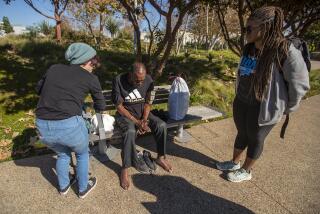Sun Spots
- Share via
The 22 tile-roofed structures dotting the concrete strand along the Los Angeles County coastline look like upscale bus shelters. And just like bus shelters, they feature advertisements the size of large movie posters.
The structures, however, are actually sun shelters for walkers, bikers and thrashed-out surfers seeking a hard-to-find spot of shade. And, because of the ads, they are at the center of a continuing dispute over commercialization at the beach.
Backers call such ads an innovative way to pay for services on the county’s 31 miles of oceanfront. Bashers call them crass and say they spoil the natural beauty of the shore.
The issue heads today to the state Coastal Commission, which at a meeting in Los Angeles is to consider after-the-fact permits for the 22 shelters, which the county installed in 1992 and 1994. The commission also is scheduled to consider permits for 23 more structures, proposed kiosks called “beach information directories.”
Since the commission isn’t in the advertising business, what’s officially at stake is permission to place such structures along the coast.
In reports filed last month, the Coastal Commission staff recommended that the panel approve the shelters and the kiosks--if the county abides by two primary conditions:
First, move a few shelters to less obtrusive locations.
Then, annually donate 10% of the ad revenue to the state Coastal Conservancy, to be used for new accessways to the beach in Malibu.
But the underlying issue--and the primary concern of opponents of the shelters--are the ads.
The shelters would not be up if it weren’t for the ads and the kiosks won’t go up if there aren’t ads; the county doesn’t have any other way to pay for them.
Moreover, opponents are concerned that if the structures are approved, further commercialization of the state’s beaches is inevitable. “It’s precedential,” said Assemblywoman Debra Bowen (D-Marina del Rey), an opponent of ads on the shelters and kiosks. “There’s nothing like [these ads] along the entire coastline of California.”
Beach advertising is the byproduct of the county’s annual budget squeeze. To cope, the Department of Beaches and Harbors has launched an aggressive marketing campaign. It has attracted sponsorships that, for instance, underwrite the cost of pickup trucks for lifeguards. It also went about securing ads for the shelters and kiosks.
*
The shelters feature two 4-foot-by-6-foot ads; so would the kiosks. Each ad costs $1,320 per month. The county gets 40% of that plus an annual fee; it would collect 50% of each kiosk ad but no annual fee.
The kiosks would also contain two other panels of similar size, one with local beach facts, the other with general beach and ocean information such as how to avoid a rip current. Plans also call for similar public service messages to be added to a third panel on the sun shelters.
Department officials contend that the structures not only help defray the costs of beach maintenance--estimated at $8.1 million in fiscal year 1998--but will also fund a program that offers ocean skills training to inner-city and foster care children.
The shelters will generate $330,000 in fiscal 1998 and the kiosks will bring in $364,000, said Dusty Crane, head of marketing at the Department of Beaches and Harbors.
Bowen, however, said the shelters run afoul of a 1995 state law, which she wrote, that bars “new or expanded commercial development” on the beach.
She said she recently saw one shelter ad that featured a bottle of hot sauce “bigger than I am.”
“I’m not opposed to having sun shelters,” she said. “I am opposed to having billboards on the beach.”
Also opposed to beach-side “billboards” are environmental groups such as the Sierra Club and Friends of California Parks, which filed suit last fall against the county over the shelters--a suit that is on hold pending Coastal Commission action.
The groups’ attorney, Frank Angel, said the ads go “against the very grain of what public parkland and public beaches were established for.”
Crane said the department’s view is that the 1995 state law applies to “real estate,” something of more substance than a prefabricated shelter that was moved in with a crane and bolted down.
She said she understands the passions the ads arouse.
“If this was a perfect world and we had lots of money, we wouldn’t do it,” Crane said. “There wouldn’t be any need.”
But, she said, if the ads are done “in taste,” the impact “is so minimal that it really far outweighs the negative.”
The first 12 shelters were installed in 1992. Ten more were installed in 1994. They now dot the county coast from San Pedro up to Malibu.
*
The shelters were installed and are maintained by New York-based Transportation Displays, Crane said. The company gets 60% of the monthly ad revenue, or $792 per ad, plus “some of the best sites in outdoor advertising,” Crane said.
County officials did not seek a Coastal Commission permit because they believed the shelters were “temporary” and therefore did not need one, Crane said. They learned otherwise late in 1994, she said, when the county received notice that it was in violation of state rules.
What has followed since has been the stuff of bureaucracy: round after round of meetings, various appearances before the Coastal Commission and a lawsuit, filed by Angel in Los Angeles County Superior Court.
County officials have welcomed the commission staff’s report recommending approval of the shelters and kiosks, even if it has come with conditions.
“Whatever it takes to make this thing work,” Crane said.
But not so fast, say opponents. “There are lots of ways to provide shelter,” Bowen said. “Trees would be nice too.”
More to Read
Sign up for Essential California
The most important California stories and recommendations in your inbox every morning.
You may occasionally receive promotional content from the Los Angeles Times.













